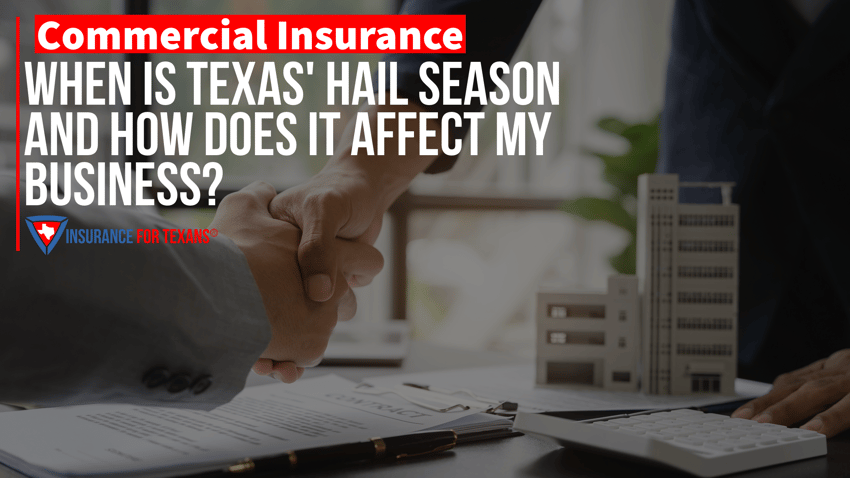There is mass chaos afoot in the Texas insurance landscape right now. The claims caused by catastrophic hail storms all across the state this year have made the insurance companies pay out hundreds of millions of dollars in claims. As a result, the insurance companies are trying to find ways to reduce their claim costs. While this may not seem like a big deal as we are kicking off High School football season since many think storm season is for the spring only, that is likely shortsighted for a couple of reasons. The trends in the business property insurance industry are not going to change for some time and the reality is that there is a second "storm season" during fall for many parts of Texas. Let's look at how this works for you and your business.
What Is Hail Season?
Hail season refers to the time of year when there is an increased likelihood of hailstorms occurring in a specific geographical region. In Texas, hail season typically spans from March to June, with peak activity in April and May. During this period, intense thunderstorms develop, bringing with them strong winds and the potential for hailstones to form. These hailstones can vary in size, ranging from small pellets to larger stones measuring several inches in diameter. Hail storms can cause significant damage to properties, including roofs, vehicles, and outdoor structures, resulting in costly repairs and property damage. Given the frequency and severity of hail events in Texas, it is important for business owners to understand the impact of hail on their operations and take appropriate measures to protect their assets and prepare for potential insurance claims.
Causes of Severe Weather Events in Texas
Severe weather events, including hail storms, are a common occurrence in Texas due to a combination of factors. One of the key contributors to these events is the warm, moist air that originates from the Gulf of Mexico. This air mass collides with cold, dry air from the north, creating the perfect conditions for the formation of thunderstorms and hail.
Texas, with its vast size and diverse geographical features, is uniquely positioned to experience these severe weather events. During hail storms, water droplets are lifted by strong updrafts within the thunderstorm's environment. These water droplets freeze as they are carried to higher altitudes, forming hailstones. The size of the hailstones can vary, with some reaching diameters of several inches. The larger the hailstone, the more damage it can cause to property.
As a business owner in Texas, it is important to be aware of the factors that contribute to these events so that you can help take necessary precautions to protect your business and minimize potential losses. Additionally, it is important to ensure that your commercial property insurance provides coverage for hail damage, as the cost of repairs can amount to thousands of dollars. By staying informed and proactive, you can better navigate Texas' hail season and its potential impact on your business.
Spring Storm Season Springs Large Hail
Texas is no stranger to extreme weather events, especially during its spring storm season. One of the most significant threats businesses in Texas face during this time is large hail. The size of hailstones can vary, but during spring, Texas experiences an increased risk of larger hail due to lower freezing levels in the clouds. This means that hailstones have a greater chance of reaching the ground without melting or evaporating.
The impact of large hail can be devastating for businesses. Hailstones measuring several inches in diameter can cause extensive damage to roofs, windows, and vehicles, resulting in costly repairs that can amount to thousands of dollars. Insurance claims for hail damage during this season are not uncommon, leaving property owners and businesses to deal with the financial burden of repairs.
Certain areas in Texas, such as the infamous "Hail Alley" in North Texas, are particularly susceptible to severe hail storms. The combination of strong winds and large hailstones can lead to catastrophic damage to commercial properties, including broken panels and structural issues.
As hail storms continue to pose a significant threat to property owners, being prepared and protected against hail damage is essential for businesses to weather the storm and minimize the financial and operational disruptions caused by these extreme weather events.
Why Does Fall Make Hail Fall Again?
During the fall season in Texas, there is a tendency for hail to fall once again. This phenomenon can be attributed to specific weather patterns and atmospheric conditions that are prevalent during this time of year.
As the summer comes to an end, Texas experiences changes in atmospheric conditions that contribute to an increased likelihood of hailstorms. One key factor is the clash between warm and cold air masses. The transition from baking hot summer temperatures to cooler fall temperatures creates instability in the atmosphere, providing the ideal conditions for the formation of thunderstorms.
Additionally, during the fall season, Texas often sees the development of strong weather systems, including cold fronts and low-pressure systems. These systems bring higher levels of moisture and instability to the region, which can lead to the formation of severe thunderstorms and, subsequently, hail.
While many people don't necessarily think about the fall being a big hail season, there is certainly an uptick in hail storms during October and even into November.As a result, businesses in Texas need to be vigilant and prepared for potential hailstorms during the fall season.
Types of Hail
Hailstones can vary widely in size and shape, and understanding the different types of hail can help business owners anticipate the potential impacts on their properties. The most common type of hail is small hail, which typically measures less than 1 inch in diameter. While small hail may not cause significant damage, it can still pose a threat to vulnerable structures and vehicles. Moderate hail, ranging from 1 to 2 inches in diameter, can cause noticeable damage to vehicles, roofs, and other property. Large hail, measuring 2 to 4 inches in diameter, is capable of causing more severe damage, including dents, broken windows, and structural damage. Finally, severe hail, which surpasses 4 inches in diameter, is extremely rare but can cause catastrophic damage, resulting in costly repairs and insurance claims.
Size of Hail Stones & Largest Ever Recorded In Texas
Texas is known for its severe weather events, including hail storms that can cause significant property damage. Hailstones can vary in size, ranging from pea-sized (around 0.25 inches in diameter) to golf ball-sized (around 1.75 inches in diameter). However, in Texas, hail stones can grow much larger than that. In fact, the largest hailstone ever recorded in Texas had a diameter of 8 inches and weighed almost 2 pounds!
The size of hail stones can greatly impact the amount of damage they can cause. Smaller hail stones are less likely to cause significant damage, but larger hailstones can result in catastrophic damage to roofs, vehicles, and other structures. They can puncture roofs, shatter windows, and dent vehicles, leading to costly repairs.
Areas Most Prone to Severe Hailstorms in Texas
The reality is that specific areas in Texas, especially North Texas, are subject to more severe hailstorms than others. These locations, commonly referred to as "Hail Alley," include cities such as Lubbock, Amarillo, Fort Worth, Dallas, McKinney and Arlington. Hail Alley stretches across the northern and central parts of the state, where climatic conditions are favorable for the formation of severe hailstorms.
Hailstorms in these areas can occur with significant frequency, especially during the peak hail season from March to May. The severity of these hailstorms is evident through the size of hailstones they produce. Hailstones in these regions can regularly reach sizes of golf balls or even larger, resulting in destructive impacts. But there is also the second storm season during the fall as weather patterns once again collide after the hot summer months.
Commercial properties are particularly vulnerable to hail damage during these severe hailstorms. Roof damage is often a common consequence, ranging from broken shingles to more severe structural damage. Windows and siding may also be shattered or dented, leading to additional repair costs. These damages can result in substantial financial losses for businesses.

How Does Hail Season Affect My Business?
Hail season in Texas can have a significant impact on businesses, particularly those located in areas prone to severe hailstorms. From roofs to windows and siding, businesses may find themselves facing structural and cosmetic damages that require immediate attention. Let's explore the various ways in which hail season can affect your business and discuss the importance of having comprehensive insurance coverage to mitigate the financial risks associated with hail damage.
Hail Coverage For Commercial Property
Texas is known for its severe weather events, including hail storms that can cause millions of dollars in property damage. One important aspect to note is the wind-hail deductible on a commercial insurance policy. This deductible specifically applies to hail and wind events. When a hail storm or other severe weather event occurs, the insurer will subtract the deductible amount from the claim payment. It is important to review and understand the specific deductible amount in your policy. If your building is valued at $1,000,000, there is a massive difference in responsibility between a 1% and 3% deductible. The 1% means that you will be paying $10,000 as part of the repairs. At 3%, you're paying $30,000. That extra $20,000 can come in handy later!
In terms of property coverage, commercial property insurance generally covers buildings, roofs, outdoor equipment, and other physical assets owned by the business including your finish outs inside and equipment. It is essential to have coverage for these areas as hail storms can cause significant damage, ranging from broken panels to catastrophic damage to your roof or building.
Do Commercial Tenants Need Hail Insurance?
Hailstorms can pose significant risks and cause extensive damages to commercial properties. As a result, commercial tenants should strongly consider obtaining hail insurance coverage for reasons you may not be considering. There are three primary reasons a tenant can be affected by a hailstorm. The first is an interruption of your business if the damage is severe enough to force you to shut down for days or even weeks. How will you pay your bills if you cannot operate your business? The second reason is that your improvements to your rented space could be damaged from water in the event of hail causing a breach of the roof or windows. The last is damage to your equipment or inventory. It's easy to overlook these items, but it can make the difference between the success and failure of your business!
Current Trends For Hail Coverage On Business Insurance
Texas business owners are witnessing significant changes in the provisions for hail coverage on their commercial property insurance policies. One of the major factors driving these changes is the increasing costs associated with hail damage. Hail storms in recent years have caused billions of dollars in property damage, leading insurers to reevaluate and adjust their coverage options.
As a result, insurance companies are raising premiums and deductibles while also potentially reducing coverage for businesses located in hail-prone areas. The rising risks associated with severe hailstorms are prompting insurers to take a more cautious approach in ensuring they can adequately cover potential losses.
If you are a Texas business that has not reviewed your commercial Texas insurance policies in some time or is one of those businesses that has received notice that coverage is being taken away, today is a great day to speak with one of the commercial insurance agents at Insurance For Texans. Our independent agents work on your behalf, rather than some giant insurance company. They will work with you to find the right coverage for your business to be protected from hail and other weather related losses.
Call us at 469.789.0220 or click the button below to begin the process of securing the right insurance for your business.


